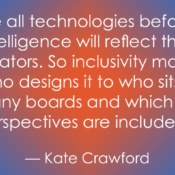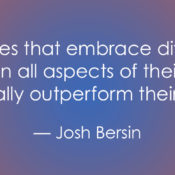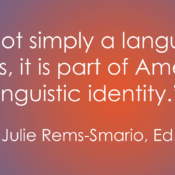
Taking Up Space: A Note on Interpreter and CODA Introspection
In last week’s blog post, I discussed the need for Deaf and hard of hearing individuals to have an active “seat at the table” to shape their unique communication accessibility experiences.
A reader raised a powerful question regarding how CODAs, particularly those who are interpreters or interpreter educators, should contribute to dialogue about the Deaf community without unintentionally taking up space where Deaf perspectives should be centered.
The reader provides a thoughtful reflection, and one that deserves a deep, nuanced response. Let’s dive in!
The Deaf Community
The Deaf community is multifaceted. Intertwined with Deaf and hard of hearing individuals are hearing significant others, children of Deaf adults (CODAs), and family members, as well as interpreters, teachers, and so many others who are indirectly influenced and impacted by the lives and experiences of these Deaf and hard of hearing individuals.
Are these hearing individuals, in fact, members of the Deaf community?
Well… it depends who you ask.
Some may say that because they’re not Deaf or hard of hearing, they do not qualify as members.
Others may say that collectively, they are “visitors” - granted access to the Deaf community that could be revoked at any time.
And there are others who claim yes - they are members of the community and should be referred to as such.
It’s important to note that one’s answer could vary based on the individual being discussed and their proximity to the Deaf community.
Ultimately, there is no “right answer” to this question… But it’s important to consider the context in which we represent the community - as a member, a visitor, or simply a friend.
CODA and the Tension of Proximity
CODAs (Children of Deaf Adults), for instance, straddle two worlds from birth - navigating both hearing and Deaf spaces. Formative experiences give CODAs deep cultural and linguistic exposure, as well as perspective into the systemic barriers and discrimination that their parents and, potentially, other family members, encounter in their daily lives (e.g., healthcare, education, etc).
This experience can build tension, however. CODAs’ proximity to the Deaf community can blur the line between being of the community and being central to its narratives. Timing is critical - one must carefully determine the appropriate moments to represent the community - or just to simply support.
There is a time and place for everything. Consider the nuances of difficult situations that are generally going to be the exception to the rule. This includes emergency situations, such as a Deaf or hard of hearing individual being in the hospital and a family member needing to immediately intervene to advocate on the individual’s behalf, ensuring effective communication takes place for potentially life-saving measures. Essentially, because of existing systemic barriers, CODAs, regardless of whether they are interpreters or not, may be put in a position where they need to interpret and advocate on behalf of their family members.
On a more holistic level, it is important to remember that while CODAs may be fluent in ASL and have an intuitive understanding of Deaf norms and communication needs, they are still hearing. They may have deep ties to the Deaf world, but they do not firsthand experience the systemic barriers, discrimination, or lived Deaf identity that Deaf people do.
When a CODAs speaks, especially in professional or educational spaces, they’re often heard. LOUDLY. This visibility and perceived authority can unintentionally shift the spotlight away from Deaf perspectives, even when that’s not the intent.
I choose to believe advocacy is well-intentioned, especially as many interpreters, CODAs or not, have observed discrimination and challenges faced by the Deaf community firsthand. As interpreters are also human, they are not immune from being impacted or subjected to the pain and frustration that their Deaf or hard of hearing family members, friends and/or clients have encountered.
Overstepping Beyond Interpreting
The conversation surrounding the way an interpreter’s advocacy can minimize Deaf perspectives is a discussion prominent within the interpreting field - but in reality, its applicability extends far beyond interpreters.
The dynamic of taking up space, or being centered by default due to proximity, happens in many areas: healthcare, academia, media, nonprofit, the work place, social media, and even within families.
The fact is: hearing individuals have easier access to platforms, credibility, and institutional trust. Whether you’re a program director, content creator, researcher, or teacher, the same questions apply:
- Am I creating space or occupying it?
- Am I sharing in a way that uplifts Deaf perspectives - or replacing them?
- Am I being deferred to because I’m hearing; and if so, what do I do with that power?
These questions aren’t only etiquette—they’re about appropriate representation.
Sharing, Without Centering
The key isn’t to go silent, it’s to show up with intentionality and care. When CODAs share from their own experiences, especially in Deaf-related professions, they can offer valuable insight… but it’s worth asking:
- Am I contributing in a way that supports Deaf-led conversations?
- Is my presence making room for Deaf perspectives—or crowding them out?
In educational or professional spaces, this means actively partnering with Deaf colleagues, incorporating Deaf-led content, and being transparent about your own positionality. It means sharing the stage—not just once, but as an ongoing practice.
The Term: “Allyship”
Too often, those who are hearing, including CODAs, self-identify as being an “ally” to the Deaf community. However, allyship is a continuous practice, not a fixed identity. Labeling oneself shifts the focus away from the communities most affected. True support is shown through consistent action, partnership, accountability, and solidarity. Recognition as an ally is best given from the impacted community members themselves, not a self-declaration.
Ultimately, what truly matters isn’t one’s background or even how they perceive themselves, but rather an effective approach to advocacy:
- Do they center and reinforce Deaf people’s perspectives?
- Are they open to continuous feedback and growth?
- Do they understand their active role within systems of privilege and oppression?
- Are they using their access to redistribute opportunity back to the community itself?
The same principles apply whether someone is interpreting, teaching, advocating, creating policy, or simply participating in Deaf spaces.
Final Thoughts: Holding Complexity with Care
Navigating identity, privilege, and responsibility in Deaf-centered spaces is complex, especially for those who feel deeply connected to the community but aren’t themselves Deaf or hard of hearing. For CODAs, the challenge is to honor their deep connection without conflating it with the lived Deaf experience. More broadly, for all hearing people, it means recognizing when support quietly turns into spotlight.
Fundamentally, advocacy is about awareness. Utilizing access and insight in service of equity, not recognition. Ultimately, we must ask ourselves hard questions - not once, but continually.
The good news is if you’re already asking how to show up without overshadowing, you’re doing the work! Keep listening. Keep adjusting. Keep centering the perspectives that should have always been there.
If you want to learn more about how you can “show up” with the Deaf community, consider reaching out to us at 2axend for various learning opportunities. Our team is committed to equip you with the skills to address individual and systemic biases, reduce barriers to accessibility and inclusion and, ultimately, improve the experiences of Deaf and hard of hearing individuals.



